Blog Post | How Does Conflict and Drought Affect Child Well-being and Educational Outcome? A Household Survey in Tigray, Ethiopia
2025.10.07
Drawing on their diverse professional backgrounds, researchers at the JICA Ogata Sadako Research Institute for Peace and Development (JICA Ogata Research Institute) bring a wealth of experience to the institute. They are actively building partnerships with a broad range of stakeholders. This blog series shares some of the insights and knowledge gained through their research activities. The present post was written by Solomon Haddis Teklehaymanot, Research Fellow, who works on the research project “Impact of conflict and drought on child wellbeing and educational outcome in Tigray, Ethiopia .” He conducted a field study in Tigray between June 12 and July 7, 2025.
Author: Solomon Haddis Teklehaymanot, Research Fellow, JICA Ogata Research Institute
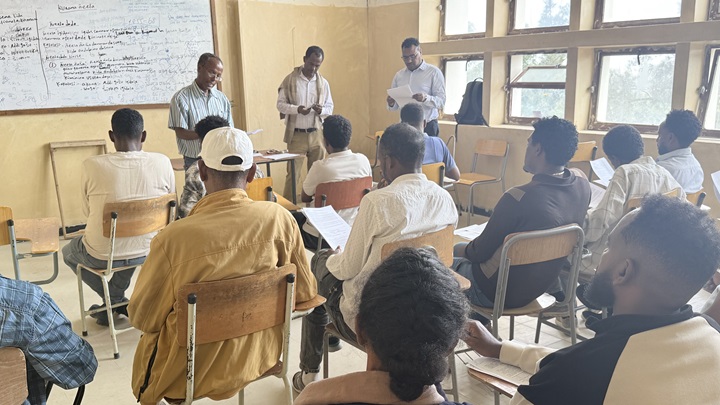
Training of enumerators on the Paper Questionnaire
The war in Tigray, Ethiopia, which began in November 2020, was devastating. It was fought between the Ethiopian federal government and the Tigray People’s Liberation Front (TPLF), with the involvement of Ethiopian National Defense Force (ENDF) and its allies: the Amhara Special Forces (ASF) and the neighboring Eritrean Defense Forces (EDF). The war ended with a ceasefire in November 2022. It destroyed infrastructure and severely undermined people’s livelihoods in the region. According to a report by the New Lines Institute measured by the number of deaths, the Tigray War in Ethiopia is the deadliest armed conflict of the 21st century and one of the bloodiest since the end of the Cold War, claiming the lives of over 400,000 soldiers and up to 300,000 civilians.
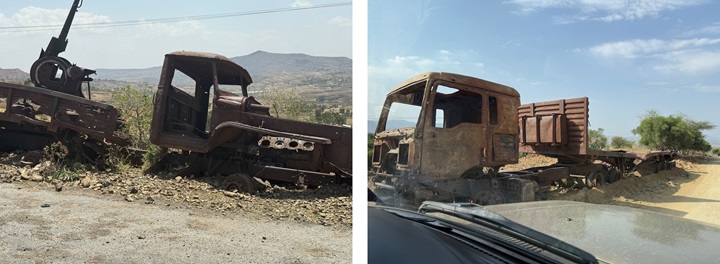
While visiting the project sites, I observed and recorded images of vehicles destroyed during the conflict.
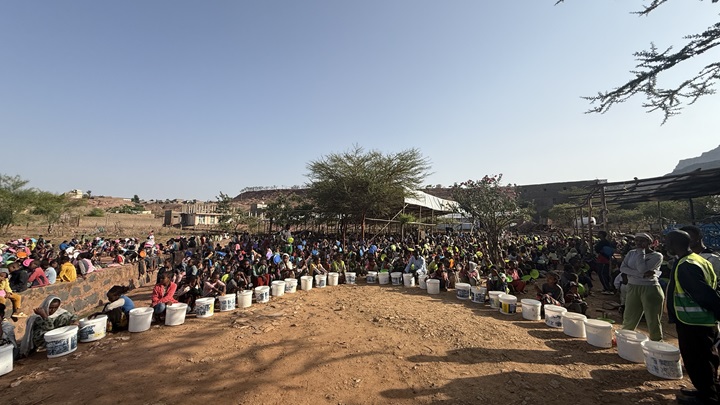
A Feeding center for internally displaced persons (IDPs), Emahoy Tsege Mariam’s humanitarian activities in Abi Adi, Tigray
The above photo was taken while I was visiting Abi Adi to learn about the humanitarian activities led by Emahoy Tsega Girmay , a nun deeply devoted to serving the most vulnerable. Despite risks and shortages, she organized local efforts to collect and distribute food, clothing, and medicine to displaced families.
When I visited the feeding center for internally displaced persons (IDPs), I was struck by the long lines of children waiting for food aid. Most of them had fled their homes after losing their parents, seeking food and safety in temporary shelters. I learned that the rations were often far less than what each child truly needed.
These children are supposed to receive adequate parental love, education, and nutrition, as they represent the next generation of the world’s population. Yet, they endure hardship while still holding on to hope. Distributing food felt both necessary and heartbreaking.
Another shock was that while visiting the schools, I realized that the education sector has been among the hardest hit by the conflict. During the war, many schools were occupied by military forces and used as bases, leading to widespread looting, destruction of academic facilities, and severe structural damage to buildings. It reminds me of a saying: “if you want a country to grow, invest in education; but if you want to destroy a country, undermine its education.” That is exactly what happened in Tigray.

Destruction at Mai Mekden Elementary School, Shewate-Higum Elementary school, and Hagerselam primary school respectively
All children in Tigray have been out of school for two years. The war has severely affected both the quality of and access to education, while trauma and psychological distress remain widespread. In the aftermath of the conflict, the region was also hit by a severe drought. These two overlapping shocks may have lasting impacts on the population in general, and on children’s educational performance in particular.
Given this background, this research project has two main objectives:
1) To generate evidence and understanding of the impact of conflict and drought on children's wellbeing and educational outcomes in the Tigray region of Ethiopia;
2) To use this evidence to inform the policy makers of the Government of Ethiopia, the Tigray Regional State, JICA and other stakeholders so that their interventions are more effective in reducing or preventing the scarring of children.
To answer the objectives outlined above, data collection was necessary, and the study incorporates both quantitative and qualitative methods. As part of the field survey, I travelled to Tigray in Ethiopia to oversee the data collection process, as well as accompany the household case studies, key informant interviews (KIIs) and focus group discussions (FGDs). KIIs were conducted with the Parent Teacher Association (PTA) and school principals, to gain in-depth insights into enrollment rate and educational quality. FGD were conducted with children and community members to discuss the impact of the conflict and drought on their livelihoods, their use of time and their aspirations. The survey was conducted from 20th June to 29th July 2025. The quantitative component included four types of questionnaires: household, student, school, and teacher, and was carried out in fifteen primary and secondary schools across nine woredas (districts). The qualitative component employed key instruments such as household case studies, KII, and FGD. Using these methods, a total of 75 sessions (five per school) were conducted with community representatives, children, school principals, Parent-Teacher Association (PTA) chairpersons, and the families of children who had dropped out of school.
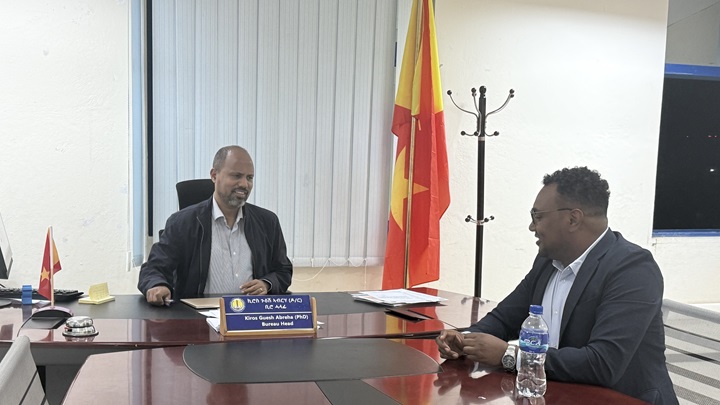
Discussion with the Head, Tigray Bureau of Education

Focus group discussions with the community and students, respectively
The Tigray community has long been known for being hardworking, honest, religious, culturally and historically rich, and valuing education. However, religious and historical sites were targeted and partly damaged during the war. Schools were also attacked, and buildings and equipments destroyed. For instance, Shewate Hugum Primary School was completely destroyed, forcing it to relocate to another school. As a result, students now spend much of their time traveling long distance to school.
In my conversations with students, teachers, and community members across different survey areas, I heard painful reflections. Many said they had lost hope in the future. They described living under a blackout for nearly two years, feeling betrayed and abandoned. The conflict deeply damaged their sense of meaning in life.
Teachers shared that they had not received salaries for 17 months and were forced to survive by trading in the streets. Students saw the destruction of their school library and laboratory, and many spoke about how their motivation to learn had declined. Some said: “After the conflict, our motivation toward education has greatly decreased.” Others added: “We are not sure about tomorrow, and we do not feel secure.” School enrollment has significantly declined following the conflict, as many students have dropped out for various reasons, including engagement in income generating activities, early (underage) marriage and migration.
From the group discussions, I learned that the war had touched nearly every household. Families lost their livestock and other assets, and all services from the federal government were cut off, including access to essential agricultural inputs such as improved seeds, fertilizer, and pesticides. As shown in the photo to the right, I witnessed many farmers using donkeys to plow their fields. This was not by choice but by necessity—having lost their oxen and other livestock, they were forced to rely on donkeys instead.
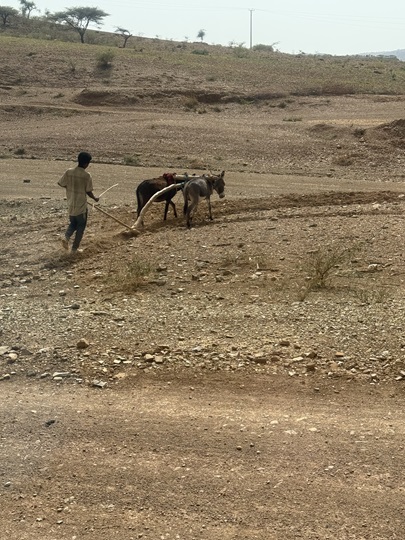
Observations from the field survey: households lost their oxen and other livestock, and had to rely on donkeys instead
War destroys lives and livelihoods. But amid the devastation, we also saw a remarkable resilience, people supporting one another internally through the hardest times. Hence, the study will analyse the qualitative data collected during the survey to answer the following questions: What are the main coping mechanisms used by the most vulnerable households in response to the combined effects of conflict and drought; and how do they affect children and their educational outcomes? It will analyse the immediate effects of the two-year conflict and drought on children and their educational outcomes using the household data collected during the survey. This research will also try to draw policy implications for the Government of Ethiopia, the Tigray Regional State, JICA and other stakeholders so that their interventions will be more effective towards the future. .... Let us work together for peace.
Disclaimer: All opinions expressed in this blog post are the author’s and do not reflect opinions of JICA or the JICA Ogata Research Institute.
Solomon Haddis Teklehaymanot
After serving as a lecturer at the Tokyo International University, he assumed his current position in 2023. His main research concerns development economics, public economics, impact evaluation, rural poverty dynamics, land property rights, migration, and human capital investment.


事業事前評価表(地球規模課題対応国際科学技術協力(SATREPS)).国際協力機構 地球環境部 . 防災第一チーム. 1.案件名.国 名: フィリピン共和国.

事業事前評価表(地球規模課題対応国際科学技術協力(SATREPS)).国際協力機構 地球環境部 . 防災第一チーム. 1.案件名.国 名: フィリピン共和国.

事業事前評価表(地球規模課題対応国際科学技術協力(SATREPS)).国際協力機構 地球環境部 . 防災第一チーム. 1.案件名.国 名: フィリピン共和国.

事業事前評価表(地球規模課題対応国際科学技術協力(SATREPS)).国際協力機構 地球環境部 . 防災第一チーム. 1.案件名.国 名: フィリピン共和国.

事業事前評価表(地球規模課題対応国際科学技術協力(SATREPS)).国際協力機構 地球環境部 . 防災第一チーム. 1.案件名.国 名: フィリピン共和国.
scroll